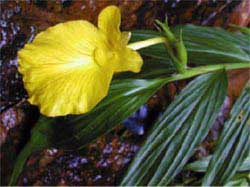Beijing, China
September 6, 2004
 Flowering plants have evolved many
different techniques to ensure pollination. For some species
self-pollination is the norm despite the genetic benefits of
cross-pollination. As an evolutionary mechanism, the selfing
process allows a plant to propagate, for instance, where
pollination agents such as wind or animals are unreliable. Flowering plants have evolved many
different techniques to ensure pollination. For some species
self-pollination is the norm despite the genetic benefits of
cross-pollination. As an evolutionary mechanism, the selfing
process allows a plant to propagate, for instance, where
pollination agents such as wind or animals are unreliable.
As reported in the Sept. 2 issue of
Nature (Vol. 431), CAS
botanists and their German collaborator have discovered a fresh
mechanism for self-pollination in the laterally orientated
flowers of a Chinese herb Caulokaempferia coenobialis, in
which a film of pollen is transported from the male anther by an
oily emulsion that slides sideways along the flower's style and
into the individual's own female stigma.
The plant first aroused the interest of doctoral student Wang
Yingqiang and his tutor Zhang Dianxiang from the CAS South China
Botanical Garden during a field survey at the Dinghushan and
Nankunshan national natural reserves in 2002. It is a deciduous
perennial herb which is endemic in the Guangdong and Guangxi
provinces of southern China, where it hangs on rock walls in
humid monsoon forests.
After careful studies in the following years, the researchers
observed pollination in the angiosperm by pollen that is
conveyed in a mobile secreted medium. The lateral flow of the
film of pollen along the style seems to be due only to the
spreading properties of the oily emulsion and not to gravity.
Analysis of the style and stigma under a scanning electron
microscope reveals a smooth style and stigma surface, and no
channels or grooves. More than 20 days of their observation
never witnessed any insects visiting the flowers that would have
touched the anthers and stigmas, even though each flower can
offer up to two microlitres of nectar containing 18% sugar.
Their studies suggest that selfing by virtue of pollen sliding
to the stigma may have evolved as a strategy to cope with a
scarcity of pollinators in the extremely shady and humid
habitats of C. coenobialis.
Scientists say this mode of self-pollination is a new addition
to the broad range of genetic and morphological mechanisms that
have evolved in flowering plants, and may be common in species
growing in shady, windless and insect-poor habitats. |